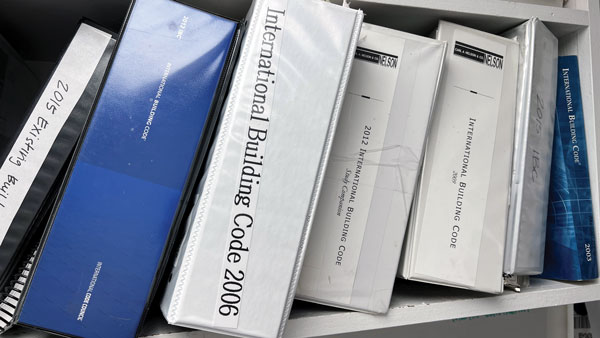Building Code application in existing buildings
 Code books occupy a shelf in the offices of Carl A. Nelson & Company in Burlington, Iowa. Knowing which code applies to a project is as important as knowing how to apply it. (CANCO photo)
Code books occupy a shelf in the offices of Carl A. Nelson & Company in Burlington, Iowa. Knowing which code applies to a project is as important as knowing how to apply it. (CANCO photo)
1 year, 10 months ago
It is crucial to know before you build which codes are applicable so they may be properly applied to your project or facility.
Code Adoption
As we’ve covered in a previous article, most codes are adopted by the state and/or local municipalities. For example, the state of Iowa has adopted a state wide fire code, plumbing code, energy code, mechanical code, electrical code, and a portion of the International Building Code (IBC). The entirety of the IBC is only applicable to specific projects in Iowa including certain facilities that are licensed by the state. Many municipalities adopt standard codes as well and projects would need to use the most stringent of either the state or local code if both are applicable. It is very important to know exactly which codes are applicable so they may be properly applied to your project/facility.
Most standardized building codes are updated on a three-year cycle. In our experience, most jurisdictions do not adopt each new version of the code and choose to adopt the newest edition every six years or another time period. Code adoptions occasionally include the verbiage “the latest edition of” the specific adopted code. In most cases, if the Owner is not doing any renovations to the building, nor changing the occupancy group of their building, nor introducing a hazardous material the building code would typically have little effect on them, with two exceptions.
International Fire Code (IFC)
Some versions of the International Fire Code (IFC) are typically adopted in most jurisdictions. Chapter 11: Construction Requirements for Existing Buildings, is applicable to existing buildings constructed prior to the adoption of the code. The purpose of the chapter is to provide minimum code requirements for existing buildings. Many newer buildings meet the requirements of this chapter and no further action is necessary. Any deficiencies in existing buildings that do not meet these requirements need to be remedied.
The first section in chapter 11 delineates fire safety requirements governing vertical openings, sprinkler systems, standpipes, fire alarm systems, and smoke alarms. The next section addresses means of egress in the building. Several items are covered here, such as: emergency exit signs and illumination, door size, guards, ramps, stairways, construction of corridor walls, and exit travel distance. Chapter 11 also includes a section specifically for I-2 occupancies, such as hospitals and nursing homes, as well as outdoor tire storage.
Chapter 8 of the IFC regulates interior finishes, furnishings, and vegetation so they do not create fire and thus life safety hazards in buildings. These requirements are applicable to both new and existing buildings.
NFPA Life Safety Code 101 (LSC)
In lieu of, or in addition to the IFC, some jurisdictions choose to adopt the NFPA Life Safety Code 101 (LSC). The LSC is adopted statewide in both Illinois and Nebraska. The Center for Medicare & Medicaid Services has also adopted the LSC to establish fire safety requirements in licensed facilities such as hospitals, longer term care facilities, and ambulatory surgery centers.
The LSC differs in format from the IFC, as the LSC has specific chapters based on occupancy for both new construction and existing buildings. Similar to chapter 11 of the IFC, the existing building chapters lay out a minimum code requirement to ensure facilities meet a minimum threshold for life safety.
As evidenced by this article, code applicability and requirements can be quite complicated. If you need assistance in achieving code compliance in your facility, please do not hesitate to contact us.

About the Author
Ellen McCulley graduated magna cum laude with a Bachelor of Architecture degree from Iowa State University, where she received the Pella Architectural Award from the Department of Architecture in the College of Design. She is a registered architect in Iowa, Illinois, Nebraska and Missouri, and joined Nelson Design, Inc., a wholly owned subsidiary of Carl A. Nelson & Company, in 2012.
How to obtain code review for your project or facility
Carl A. Nelson & Company is available to help clients address code-related issues in their facilities. Call (319) 754-8415 and ask for Ellen McCulley. Review past installments of Decoding the Code at www.carlanelsoncoconstruction.com/decoding-the-code/